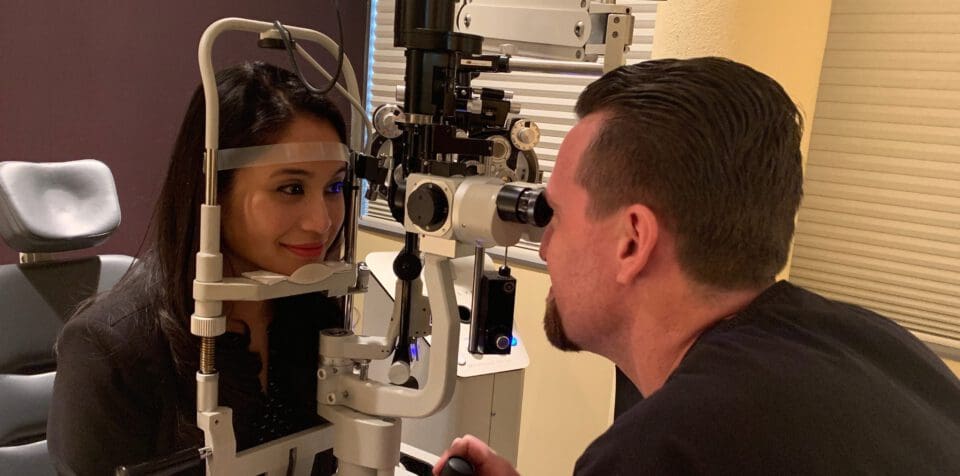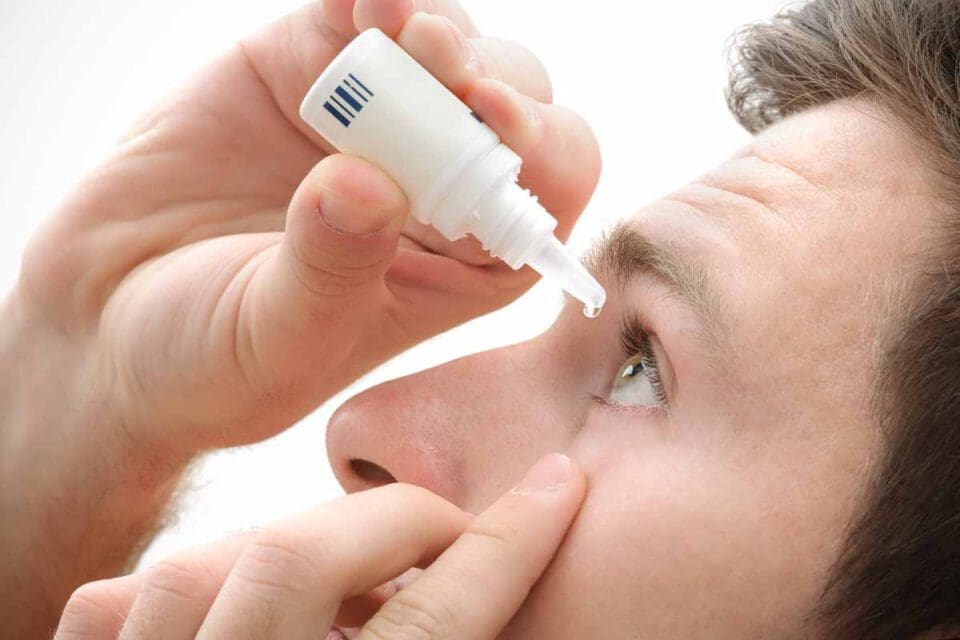Everything You Need to Know About Fuchs’ Dystrophy
Home / Eye Conditions & Eye Diseases /
Last Updated:
Fuchs’ dystrophy is a progressive eye condition, where a fluid imbalance in the cornea leads to a buildup of cells that causes the eye to swell. Patients experience physical pain and increasingly cloudy and distorted vision.
Table of Contents
The condition usually manifests in middle age, and it is most frequently found in women. It is hereditary, but to what degree it is passed down through genes is not fully understood.
If detected early, the symptoms can be easily treated with eye drops and photometric glasses. If the condition persists, surgery will ultimately be required.
What Is Fuchs’ Dystrophy?
Fuchs’ dystrophy is a medical condition that causes the cornea (the clear layer) on the front of the eye to swell. This can cause cloudy vision, the perception of a glare in vision, and physical discomfort to the eye.
Mayo Clinic writes that Fuchs’ dystrophy can strike both eyes, and it can cause a patient’s vision to gradually diminish over a matter of years. Most of the people who get Fuchs’ dystrophy won’t develop any symptoms until they are in their 50s.
There are medications and self-care treatments that can relieve some of the signs and symptoms of Fuchs’ dystrophy. As the condition gets more advanced and vision is lost, a patient will need cornea transplant surgery to stop the damage and restore vision.
Fuchs’ dystrophy will not result in total blindness, even in patients who have very advanced states of the condition. The dystrophy does not affect the retina or the optic nerve.
Symptoms

Symptoms of Fuchs’ dystrophy include:
- A persistent glare, which can reduce vision in both dim and bright light.
- Blurred vision, occurring in the morning after waking up, but gradually getting better as the day goes on. If the dystrophy is not treated, the blurred vision can take longer to improve, or it doesn’t improve at all.
- Pain, as the result of tiny blisters on the surface of the cornea.
You deserve clear vision. We can help.
With 135+ locations and over 2.5 million procedures performed, our board-certified eye surgeons deliver results you can trust. Your journey to better vision starts here.
Other symptoms include seeing colored halos around lights, poor night vision, and the feeling of something physical in the eye.
Causes of Fuchs’ Dystrophy
What causes Fuchs’ dystrophy? In a healthy eye, the cells that line the inside of the cornea maintain a normal balance of the fluids that reside in the cornea, and they stop the cornea from swelling.
When a person develops Fuchs’ dystrophy, those cells slowly start to die, and the balance of fluids is tipped. The fluid builds up, a process known as edema. This is what leads to the thickening of the cornea and the blurred vision. What causes this process to happen is not fully understood.
Fuchs’ dystrophy can be passed down through genes, but there is no way to accurately predict whether family members will get the full brunt of the condition or not develop it at all. For similar reasons, there is no known way of preventing Fuchs’ dystrophy.
There are, however, risk factors for Fuchs’ dystrophy that patients should be aware of.
- Women are slightly more likely to develop the condition than men.
- Having a history of Fuchs’ dystrophy in the family increases the chance of it developing.
- The development of Fuchs’ dystrophy begins in one’s 20s and 30s, with the symptoms typically showing themselves around age 50 or 60. There is a form of rare early-onset Fuchs’ dystrophy that begins in childhood.
According to the National Eye Institute, smoking and diabetes might also increase the chances of developing Fuchs’ dystrophy.
Detecting Fuchs’ Dystrophy
As part of the exam, the doctor will use a slit lamp to carry out an intricate examination of the cornea. They will use very high magnification to examine the cornea, looking for subtle changes in the balance of its fluids and the presence of any cells in the cornea that should not be there.
The early signs of Fuchs’ dystrophy are a reduced number of cells and microscopic lesions in the cornea, which have their own name: corneal guttata.
Measuring the corneal thickness (in order to detect swelling) is another way of detecting the development and progress of Fuchs’ dystrophy.
Additionally, visual acuity testing (using the classic eye chart) can reveal decreased vision that, with the presence of other risk factors and symptoms, might point a doctor toward a diagnosis of Fuchs’ dystrophy.

Other Testing Methods
In addition to vision testing, an eye doctor might also recommend more procedures to better determine whether a patient has Fuchs’ dystrophy. They include:
- Corneal pressure test. The eye is first numbed with drops. Then, the doctor briefly touches the eyes with an instrument designed to measure eye pressure. This differentiates between Fuchs’ dystrophy and any other disease that increases pressure on the eye, such as glaucoma.
- Corneal cell count. Another instrument records the number, the shape, and the size of the cells that line the rear of the cornea. An unusually high number would strongly suggest the development of Fuchs’ dystrophy and the extent of the condition.
You deserve clear vision. We can help.
With 135+ locations and over 2.5 million procedures performed, our board-certified eye surgeons deliver results you can trust. Your journey to better vision starts here.
How Is Fuchs’ Dystrophy Treated?
There are nonsurgical and self-care treatment options that can relieve the discomfort of Fuchs’ dystrophy, but the more advanced the condition and the greater the degree of vision loss, the more likely it is that surgery is the only method that will restore vision and comfort.
Patients who receive surgery for their Fuchs’ dystrophy are typically in an advanced stage of the condition, and they can benefit from improved vision and a complete removal of symptoms. This will be a process known as corneal transplantation: replacing the back layer of the cornea with healthy tissue from a compatible donor. This is simple enough to do in an outpatient setting with only local anesthesia.

Home Remedies
An eye doctor will almost certainly suggest lifestyle and home remedies in addition to any medical treatment. These are intended to reduce the glare in the eyes and to soothe the physical discomfort of the fluid imbalance. They are most effective when done early in the development of Fuchs’ dystrophy. If pain is debilitating and too much vision has been lost, then the only available remedy is surgery.
- Over-the-counter salt solution (5 percent sodium chloride) can be applied, either in eyedrop or ointment form.
- Wraparound sunglasses with ultraviolet protection should be worn. Photophobia (extreme sensitivity to light) caused by the dystrophy can be countered by wearing glasses with photochromic lenses (lenses that darken when exposed to specific intensities of light and clear when that level of light is gone). Additionally, anti-reflective coating removes reflections in the lens of eyeglasses, which can be troublesome to patients who have Fuchs’ dystrophy.
- Dry the eyes with a hairdryer. Medscape explains that a hairdryer kept at arm’s length and set to warm (not hot), for 10 minutes, can help to remove excess fluid in the corner and reduce swelling. If this is done upon waking up, the patient will likely not have significant discomfort or loss of vision for the rest of the day.
The availability of treatments, and their effectiveness, is based on the stage of the condition. Remedies for Fuchs’ dystrophy are also based on the eye condition and overall health of the patient.
For example, a patient with ocular hypertension will likely be recommended glaucoma eye drops to lower intraocular pressure. High eye pressure can increase the damage done by the dystrophy by further weakening the corneal endothelium.
Other Ramifications of Fuchs’ Dystrophy

Being diagnosed with Fuchs’ dystrophy means that certain procedures to improve vision are no longer an option. For example, surgery to remove cataracts may not be possible.
Healthline warns that there is a possibility of developing cataracts simultaneously with Fuchs’ dystrophy. If this happens, patients will need two surgeries together — one for the cataract removal and another for the corneal transplant. Cataract surgery can damage the endothelial cells created by the development of Fuchs’ dystrophy.
What You Need to Know About Fuchs’ Dystrophy
It is important to remember that Fuchs’ dystrophy is a progressive condition, which means it gets increasingly worse the longer it is untreated. Regular eye exams after age 30 will likely catch the development of the dystrophy before it results in eye pain and loss of vision beyond age 50.
Although there is no cure, it is possible to treat the condition such that its effects are controlled, and the loss of vision is minimized. The surgery to correct Fuchs’ dystrophy is fairly simple. When conducted, it can restore sight and eliminate the physical discomfort.
You deserve clear vision. We can help.
With 135+ locations and over 2.5 million procedures performed, our board-certified eye surgeons deliver results you can trust. Your journey to better vision starts here.
References
- Fuchs’ Dystrophy. (February 15, 2018). Mayo Clinic.
- What Is Fuchs’ Corneal Dystrophy? (April 16, 2018). WebMD.
- Facts About the Cornea and Corneal Disease. (May 2016). National Eye Institute.
- Corneal Transplantation: From Donor to Recipient. (May 19, 2015). University of Iowa Health Care.
- Fuchs’ Dystrophy. Cornea Research Foundation of America.
- Living With Fuchs’ Dystrophy. (June 12, 2017). Verywell Mind.
- Fuchs Endothelial Dystrophy Treatment & Management. (May 4, 2018). Medscape.
- Fuchs’ Dystrophy. (September 7, 2017). Healthline.
This content is for informational purposes only. It may have been reviewed by a licensed physician, but is not intended to serve as a substitute for professional medical advice. Always consult your healthcare provider with any health concerns. For more, read our Privacy Policy and Editorial Policy.